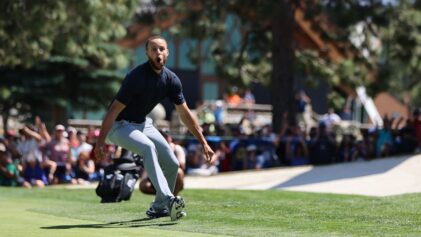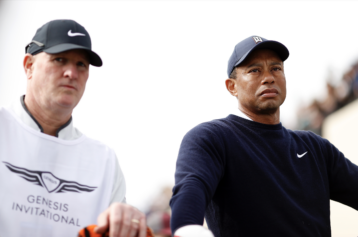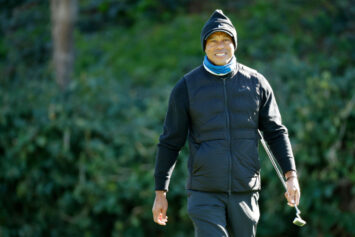The youth movement on the PGA Tour is at an all-time high with a healthy crop of dominant players ranging from their 20s to mid 30s taking center stage on a weekly basis.
Among the diverse cluster of superstars atop the world rankings and collecting championships are Rory McIlroy, 26, Jordan Spieth, 22, Jason Day, 27, Rickie Fowler, 26, Dustin Johnson, 31, and Bubba Watson, 36, just to name a few.
Along with their magic touch on the links, theyve also reaped prime earnings from top-tier corporate sponsors whove decorated their wardrobe and equipment with their logos.
This week, these players are headlining at Atlantas East Lake Golf Club, competing in the TOUR Championship (Sept. 24-27) with the hopes of securing the seasons ultimate prize – the FedEx Cup.
There will be a throng of fans at East Lake, and a national television audience at home, watching to see which of the games bright phenoms will add to their growing legacy.
But noticeably absent from this youthful surge on the PGA Tour are African- American players.
Black golfers are no strangers to playing as professionals. Men like Charlie Sifford, Calvin Peete, Lee Elder, Pete Brown, Ted Rhodes and Bill Spiller were all highly competitive on the PGA Tour.
On the womens side, Althea Gibson, Renee Powell and LaRee Pearl Sugg served as torchbearers as well.
(Photo credit: PGA)
Back in the late 1990s, there was a popular belief that thered be an influx of black golfers following in the footsteps of Tiger Woods and vying for a PGA Tour card. However, in the two decades since he became one of the most dominating and accomplished athletes in the world, not to mention him giving a huge boost to the sports television ratings, black representation on the Tour has been almost non-existent.
Like any sport, a passion for the respective game begins at an early age. Across the landscape, summertime afternoons are filled with youngsters playing T-ball and/or little league baseball, attending basketball camps and prepping for football in the fall.
In terms of golf, perhaps the top national program dedicated to introducing similar-aged children to the game is The First Tee, which teaches kids swing techniques, rules, etiquette and builds character for players from early elementary school through high school.
Although The First Tee has helped thousands foster a love for golf, it appears as if some black participants trade in their clubs for a football helmet or basketball once they reach high school. This abandonment has a crippling trickle-down effect. It lessens the chances of earning a collegiate athletic scholarship, which can serve as a potential springboard for a professional career.
I believe those who continue to play golf throughout high school and ultimately compete for scholarships, are those who develop a true, intrinsic passion for the game, said Marvin Hightower, executive director of The First Tee of Atlanta. If an athlete does not have a level of dedication to the game similar to that found in those pursuing basketball, football or other sports, playing well throughout high school and earning a golf scholarship will be very difficult.
Since recruiting and the process of securing golf scholarships differs from that in other sports, its important for athletes and their parents to understand the differences, Hightower continued. This type of support and guidance is an important element in keeping high school students, who embrace the game, engaged and on the road to potential scholarships funds.
The majority of black golfers who are fortunate enough to earn athletic scholarships compete on HBCU teams. Black colleges allow players to not only compete against fellow HBCUs, but traditional schools too. However, there are several challenges along the way.
While all four HBCU conferences (SWAC, MEAC, CIAA and SIAC) have golf included in their spring sports schedule, not all the schools have a mens and womens program. This is due in large part to economics. HBCU athletic budgets have serious financial woes and the bulk of the funds are dedicated to high revenue sports like football and basketball. This leaves little funding for programs such as golf to use for recruiting, equipment and travel expenses.
Johnson C. Smith University Golf Team (2014)
(Photo credit: NBCAHOF)
HBCU golf is vital in providing opportunities for student-athletes to gain an education. However, HBCU golf is struggling due to funding, said Dr. Gary Grandison, head coach of the 2015 SWAC mens and womens golf championship teams at Alabama State University. There are efforts to strengthen HBCU golf. There are opportunities to grow HBCU golf. It provides valuable resources for our kids to play. In the future, I expect for HBCU golf to get stronger and to see more players on the Tour.
Recently, former East Carolina University star Harold Varner III, 25, earned his Tour card through the Web.com Tour. Varner III was 25th on the money list for the circuit, which confirmed his status to now compete as a Tour pro.
In addition to Varners presence on the PGA Tour, Sadena Parks and Cheyenne Woods, who is Tigers niece, are two budding greats on the LPGA Tour who are broadening the view of black women golfers. Parks and Woods will soon likely be joined by current Stanford Cardinal Mariah Stackhouse.
Stackhouse has won a host of amateur titles including Georgia Womens Match Play (2007-08) and Georgia Womens Amateur (2008-09). She is a four-time winner of the Georgia State Womens Golf Association Player of the Year Award (2007-10) and was the first African- American player to be named to the USA Curtis Cup Team.
Varner III, Parks, Woods and Stackhouse are tremendously talented and have the potential to excel as professionals. They can also help to inspire younger players of color to work on their craft in order to someday pursue a dream of competing against the best in the world.
Enhanced marketing and brand awareness from the PGA, LPGA and USGA is of the utmost importance in winning over a young black audience. Right now, football is the king and basketball the most accessible, but golf can provide just as much of a positive impact if it is promoted correctly within the black community.
I believe the PGA and USGA should continue to identify strategic initiatives that specifically target increasing the percentage of minority golfers, especially youth, said Hightower. I also believe the PGA/USGA should consider creating broadcast, print and social media promotional campaigns that resonate culturally within the black community. As much as Ricky Fowler’s dress and look has captured the eye of a younger demographic, campaigns that make the game of golf more appealing on a cultural level could result in a new wave of young African American golfers.
But for now, everyone is still waiting and watching for the next Tiger Woods.





